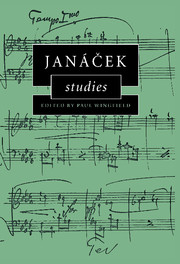Book contents
- Frontmatter
- Contents
- Preface
- 1 Expressive sources and resources in Janáček's musical language
- 2 ‘Nothing but pranks and puns’: Janáček's solo piano music
- 3 Narrative in Janáček's symphonic poems
- 4 Evasive realism: narrative construction in Dostoyevsky's and Janáček's From the House of the Dead
- 5 Direct discourse and speech melody in Janáček's operas
- 6 Kundera's eternal present and Janáček's ancient Gypsy
- 7 Janáček's folk settings and the Vixen
- 8 Janáček's operas in Australia and New Zealand: a performance history
- 9 Janáček's Moravian publishers
- 10 Janáček, musical analysis, and Debussy's ‘Jeux de vagues’
- Index
3 - Narrative in Janáček's symphonic poems
Published online by Cambridge University Press: 22 September 2009
- Frontmatter
- Contents
- Preface
- 1 Expressive sources and resources in Janáček's musical language
- 2 ‘Nothing but pranks and puns’: Janáček's solo piano music
- 3 Narrative in Janáček's symphonic poems
- 4 Evasive realism: narrative construction in Dostoyevsky's and Janáček's From the House of the Dead
- 5 Direct discourse and speech melody in Janáček's operas
- 6 Kundera's eternal present and Janáček's ancient Gypsy
- 7 Janáček's folk settings and the Vixen
- 8 Janáček's operas in Australia and New Zealand: a performance history
- 9 Janáček's Moravian publishers
- 10 Janáček, musical analysis, and Debussy's ‘Jeux de vagues’
- Index
Summary
To claim that Janáček is unorthodox in his artistic procedures never provokes surprise, since almost all the techniques and attitudes of his mature music went against the grain of convention to some extent. His word-setting, his orchestration, his treatment of large-scale and small-scale structure, his views on harmony, theory and language, his style of notation and his methods of work, even his unforeseen late flowering – all these betray a mind which was never inclined to follow a worn groove. He was not an iconoclast simply in order to be rebellious; he preferred always to devise his own methods and pursue his instincts wherever they might lead.
In the case of the three symphonic poems – Šumařovo dítě (The Fiddler's Child; 1912–13; rev. 1914), Taras Bulba (1915–18) and Ballada blanická (The Ballad of Blaník; 1919) – his instincts led to an additional unorthodoxy that is scarcely to be found in his other music. This arises from the fact that all three are based on narrative literary sources and purport to convey the content of those works, as all symphonic poems do, without recourse to words. So Janáček's celebrated concern for the ‘melodic curves of speech’ (nápěvky mluvy) has no actual words to build on.
- Type
- Chapter
- Information
- Janácek Studies , pp. 36 - 55Publisher: Cambridge University PressPrint publication year: 1999

